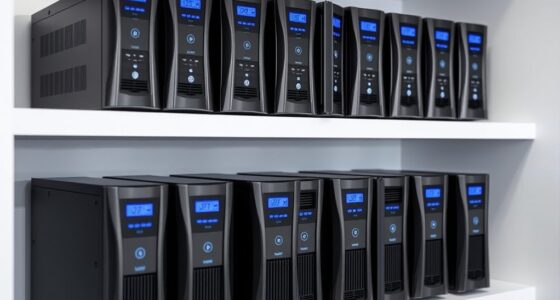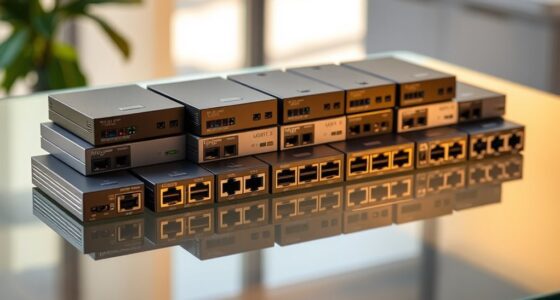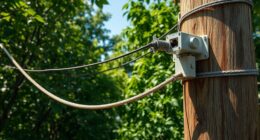If you’re looking for the best PoE switches for VoIP, I recommend options with reliable power delivery, gigabit speeds, and manageable management features. Top choices include models from TP-Link, NETGEAR, and REOLINK, offering varied port counts and high power budgets up to 30W per port. Whether managed or unmanaged, these switches guarantee seamless connectivity and stable power for your VoIP devices. Keep exploring, and you’ll discover the perfect fit for your network needs.
Key Takeaways
- Support for IEEE 802.3af/at standards with high PoE power budgets ensures reliable device powering for VoIP setups.
- Gigabit Ethernet ports and high switching capacities provide seamless, high-speed connectivity for VoIP and related devices.
- Managed options with VLAN, QoS, and network monitoring optimize voice traffic quality and network security.
- Durable, fanless designs with easy installation options suit various environments, ensuring reliable, silent operation.
- Extended PoE transmission distances and surge protection enhance outdoor and long-distance VoIP deployments.
TP-Link TL-SG1005P 5-Port Gigabit PoE Switch
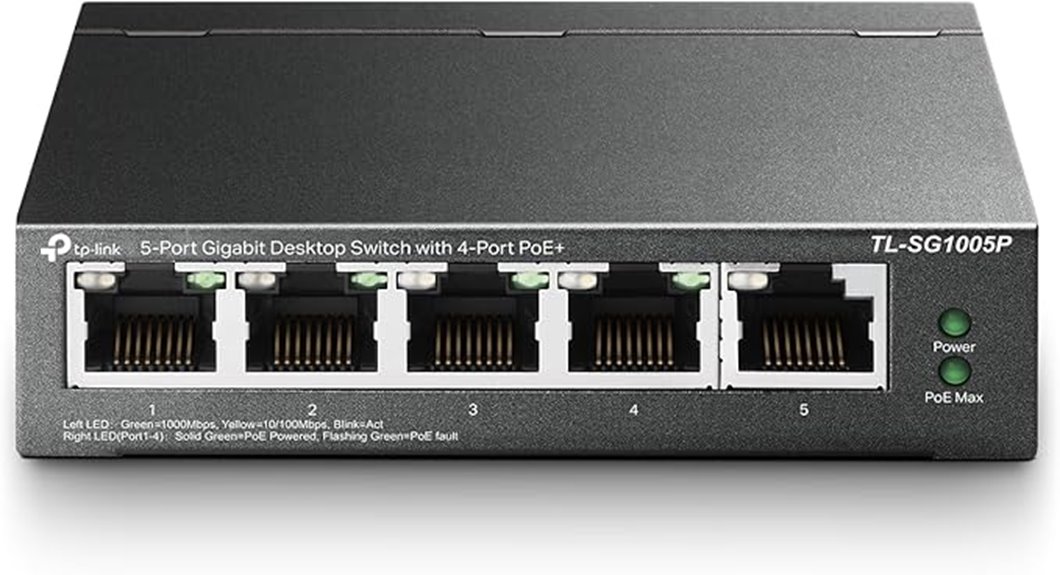
If you’re setting up a VoIP system and need a reliable, easy-to-install switch, the TP-Link TL-SG1005P is an excellent choice. This 5-port Gigabit Ethernet switch offers four PoE+ ports supporting 802.3at/af standards, delivering up to 30W per port with a total PoE budget of 65W. Its sturdy metal case and compact design make it suitable for various environments, whether on a desk or wall-mounted. With plug-and-play setup, no software is needed, so you can deploy it quickly. Advanced features like QoS and IGMP Snooping ensure smooth video and voice transmission, making it ideal for VoIP applications.
Best For: small to medium-sized businesses or home offices needing a reliable, plug-and-play PoE switch for VoIP, IP cameras, and network devices.
Pros:
- Easy plug-and-play setup with no software installation required
- Supports high-power PoE+ ports delivering up to 30W each
- Quiet fanless design suitable for noise-sensitive environments
Cons:
- Limited to 5 ports, which may require additional switches for larger networks
- No managed switch features for advanced network configuration
- Fixed PoE power budget of 65W, which might be insufficient for extensive PoE deployments
NETGEAR 5 Port PoE Gigabit Ethernet Switch (GS305EP)

The NETGEAR GS305EP stands out as an affordable, easy-to-manage option for small to medium businesses seeking reliable PoE power for VoIP phones and other network devices. It offers 4 PoE+ ports with a total 63W power budget, supporting devices like IP phones, cameras, and access points. Its gigabit ports and port aggregation improve throughput, while the user-friendly web GUI simplifies configuration for VLANs, QoS, and PoE management. Compact and silent, it suits noise-sensitive environments. Although it lacks CLI access and advanced VLAN features, its reliability, energy efficiency, and value—around $7.50 per port—make it a solid choice for powering multiple network devices.
Best For: small to medium businesses seeking an affordable, reliable PoE switch to power IP phones, cameras, and access points with easy management.
Pros:
- Cost-effective with a high power budget of 63W for PoE devices
- User-friendly web GUI for straightforward configuration of VLANs, PoE, and QoS
- Compact, silent operation suitable for noise-sensitive environments
Cons:
- Lacks CLI access and advanced VLAN management features
- Limited visibility into MAC address tables, complicating troubleshooting
- Does not support full 802.3ad link aggregation and lacks rackmount options
TP-Link TL-SG1005P 5-Port Gigabit PoE Switch

For small offices or home setups needing a reliable PoE switch, the TP-Link TL-SG1005P stands out with its easy plug-and-play design and robust performance. It offers five Gigabit ports, including four PoE+ ports supporting 802.3at/af standards, delivering up to 30W per port with a total power budget of 65W. Its sturdy metal case and flexible mounting options make it versatile for different environments. Features like QoS and IGMP Snooping ensure smooth video and voice traffic, while fanless operation guarantees silent performance. Backed by a 3-year warranty and free support, it’s an excellent choice for seamless connectivity and power delivery.
Best For: small offices or home setups requiring a reliable and easy-to-manage PoE switch for high-speed connectivity and power delivery.
Pros:
- Plug-and-play setup with no software configuration needed for quick deployment
- Supports 4 PoE+ ports with up to 30W per port and a total budget of 65W
- Quiet fanless design suitable for noise-sensitive environments
Cons:
- Limited to 5 ports, which may not suffice for larger network setups
- No advanced management features like VLAN or SNMP
- No support for gigabit uplink beyond the included ports
TP-Link 5 Port Fast Ethernet PoE Switch

The TP-Link 5 Port Fast Ethernet PoE Switch stands out as an excellent choice for small businesses or home offices seeking a reliable, quiet, and easy-to-manage network solution. Its sturdy metal casing and shielded ports ensure durability and stability, while the fanless design keeps operation silent. With four PoE+ ports delivering up to 30W each and a total power budget of 67W, it supports powering VoIP phones easily. Features like PoE Auto Recovery and flexible modes, including Extend Mode for long-distance data and power transmission, enhance its versatility. Plus, its plug-and-play setup and three-year warranty make it a dependable, hassle-free addition to any network.
Best For: small businesses and home offices seeking a reliable, quiet, and easy-to-manage network switch with PoE capabilities.
Pros:
- Durable metal casing with shielded ports for enhanced stability
- Fanless design ensures silent operation suitable for quiet environments
- Supports Extend Mode for long-distance data and power transmission up to 250 meters
Cons:
- Data transfer speed reduces to 10 Mbps in Extend Mode, limiting bandwidth over long distances
- Limited to 5 ports, which may be insufficient for larger network setups
- No advanced management features, making it less suitable for complex network configurations
NETGEAR 8-Port PoE+ Gigabit Switch (GS308PP)

If you’re looking for a reliable and straightforward PoE switch to power VoIP phones and network devices, the NETGEAR 8-Port PoE+ Gigabit Switch (GS308PP) is an excellent choice. It features 8 Gigabit Ethernet ports, all supporting PoE+ with a total power budget of 83W, ensuring ample power for multiple devices. Setup is a breeze with its plug-and-play design—no software or configuration needed. You can easily place it on a desktop or wall mount for flexible deployment. Plus, it comes with a 3-year limited hardware warranty, highlighting NETGEAR’s confidence in its dependable performance.
Best For: small to medium-sized businesses or home offices seeking a reliable, easy-to-install PoE switch for powering VoIP phones and network devices.
Pros:
- Simple plug-and-play setup requiring no software or configuration
- Supports all 8 ports with PoE+ and a total power budget of 83W
- Compact design with options for desktop or wall-mount installation
Cons:
- Unmanaged switch with limited advanced configuration options
- Power budget may be insufficient for high-power devices in larger setups
- No additional features such as VLAN or network management capabilities
TP-Link LS108GP 8-Port PoE Gigabit Ethernet Switch

When selecting a PoE switch for VoIP applications, reliability and ease of deployment are crucial, and the TP-Link LS108GP stands out with its plug-and-play setup and auto-recovery feature. It offers 8 PoE+ ports, each providing up to 30W, with a total budget of 65W, suitable for powering VoIP phones and cameras. Its fanless, durable metal case makes it ideal for both desktop and wall-mount installation. The switch supports extended PoE transmission of up to 820 feet, perfect for large areas. With 16 Gbps switching capacity, it ensures fast, stable connections, making deployment straightforward and reliable.
Best For: small to medium-sized businesses or home users seeking a reliable, easy-to-deploy PoE switch for VoIP, surveillance cameras, and network devices.
Pros:
- Plug-and-play setup for quick and easy installation without configuration
- Auto-recovery feature ensures stable network operation for PoE devices
- Extended PoE transmission up to 820 feet ideal for large areas or outdoor deployment
Cons:
- Limited total PoE power budget of 65W may restrict the number of high-power devices supported simultaneously
- No built-in management or advanced configuration options for network customization
- Fanless design, while silent, may lead to overheating in high-temperature environments
8 Port Gigabit PoE+ Switch with Rack Mount

For small to medium-sized networks requiring reliable Power over Ethernet for VoIP phones and IP cameras, a Port Gigabit PoE+ Switch with Rack Mount offers a practical and efficient solution. This device features 8 Gigabit PoE+ ports and 2 uplink ports, supporting IEEE 802.3af/at standards with a total power budget of 120W. Its sturdy metal housing and rack mount ears make installation straightforward, while LED indicators aid in quick device management. With plug-and-play setup and power support up to 30W per port, it ensures seamless connectivity and reliable device operation, making it ideal for expanding office or home networks.
Best For: small to medium-sized offices or home networks needing reliable PoE power for IP cameras, VoIP phones, and other network devices.
Pros:
- Supports IEEE 802.3af/at standards with a total power budget of 120W for multiple devices
- Easy plug-and-play installation with built-in power adapter and rack mount ears
- Durable metal housing suitable for various environments with LED indicators for easy device management
Cons:
- Does not support passive 24V PoE devices such as Ubiquiti access points
- Limited to 8 PoE ports, which may be insufficient for larger network setups
- No advanced management features like VLAN or QoS settings
Poe Texas PoE Injector, Single Port Power Over Ethernet Adapter

The Poe Texas PoE Injector, Single Port Power Over Ethernet Adapter stands out as an ideal choice for small-scale deployments that require reliable, gigabit-speed power and data transmission. Its compact design makes it easy to install near outlets or under desks, reducing clutter. Supporting 10/100/1000 Mbps speeds, it powers devices like IP cameras, VoIP phones, WiFi access points, and LTE radios over Ethernet cables. Compatible with passive 802.3af and PoE+ standards, it accepts input voltages from 12V to 56V. While simple and efficient, correct polarity wiring and suitable power supplies are essential for best performance.
Best For: small offices or home setups needing reliable gigabit PoE power and data over short distances for devices like cameras, phones, and WiFi access points.
Pros:
- Compact size allows easy installation and minimal clutter
- Supports gigabit speeds for fast data transmission
- Compatible with passive 802.3af and PoE+ standards for versatile device support
Cons:
- Requires correct polarity wiring to function properly
- Power supply not included, requiring additional purchase
- Limited to short-range applications; longer distances may reduce performance
NETGEAR 5-Port PoE Gigabit Ethernet Unmanaged Switch (GS305P)

If you’re seeking a straightforward, reliable PoE switch for small VoIP setups, the NETGEAR 5-Port PoE Gigabit Ethernet Unmanaged Switch (GS305P) is an excellent choice. It offers five gigabit ports, including four PoE+ ports supporting IEEE802.3at, with a total power budget of 63W. Designed for simple, plug-and-play deployment, it requires no software configuration. Its compact, silent design makes it suitable for noise-sensitive environments, and it supports flexible placement on desktops or walls. Plus, with energy-efficient operation and a 3-year warranty, it combines reliability and ease of use for small-scale VoIP and device connectivity needs.
Best For: small businesses or home offices needing a reliable, easy-to-use PoE switch to power IP cameras, VoIP phones, and wireless access points without complex setup.
Pros:
- Plug-and-play with no software or configuration required
- Compact, silent design suitable for noise-sensitive environments
- Supports up to 63W total PoE power across four ports
Cons:
- Limited to unmanaged switch features without advanced configuration options
- Only designed for use in the U.S. and Canada, restricting regional compatibility
- No additional management or monitoring capabilities
5-Port Ethernet PoE Switch with Extend Function

A Port Ethernet PoE Switch with Extend Function is ideal for network setups that require powering devices over long distances without sacrificing bandwidth. This 5-port switch offers four managed PoE ports (2×1000M, 2×100M) plus a 1000M uplink, supporting IEEE802.3af/at standards and up to 30W per port. Its extend mode allows data transmission up to 250 meters, far beyond standard limits, perfect for large buildings or outdoor installations. The switch features a fanless design, LED indicators for monitoring, and supports remote management via app or web interface. Its durable metal housing and lightning protection guarantee reliable, long-term operation in various environments.
Best For: small to medium-sized businesses or large residential installations needing long-distance PoE device power and network extension.
Pros:
- Supports extend mode for data transmission up to 250 meters, ideal for large or outdoor setups
- Managed PoE ports with up to 30W per port, suitable for IP cameras, access points, and other PoE devices
- Durable, fanless metal housing with lightning protection for reliable, long-term operation
Cons:
- Limited to 5 ports, which may not suffice for larger network expansions
- Requires compatible active PoE splitters for powering non-PoE devices
- Might lack advanced management features found in higher-end switches, limiting customization options
YuanLey 24 Port PoE Switch with 2 Gigabit Ethernet Uplink

Designed for seamless VoIP integration, the YuanLey 24 Port PoE Switch offers 24 PoE+ ports with automatically detected power support, making it an excellent choice for expanding or upgrading network setups. Its built-in 400W power supply supports IEEE 802.3af/at devices, delivering up to 30W per port. The switch also features 2 Gigabit Ethernet uplinks and 2 SFP ports for high-speed data transfer. Equipped with AI Watchdog, it automatically detects and recovers unresponsive devices, reducing maintenance. With plug-and-play installation and VLAN isolation, it’s perfect for IP phones, cameras, and access points, ensuring reliable, long-distance connectivity in professional environments.
Best For: small to medium-sized businesses and professional environments seeking reliable, high-power PoE connectivity for IP cameras, VoIP phones, and wireless access points.
Pros:
- Supports 24 PoE+ ports with automatic device detection and power management
- Features AI Watchdog for automatic device recovery, reducing maintenance
- Easy plug-and-play setup with versatile installation options
Cons:
- Limited to 10/100Mbps speeds on PoE ports, which may be insufficient for high-bandwidth applications
- No built-in management interface for advanced network configuration
- May require additional cooling in high-temperature environments due to industrial-grade fans
REOLINK PoE Switch with 8 PoE and 2 Gigabit Uplink Ports
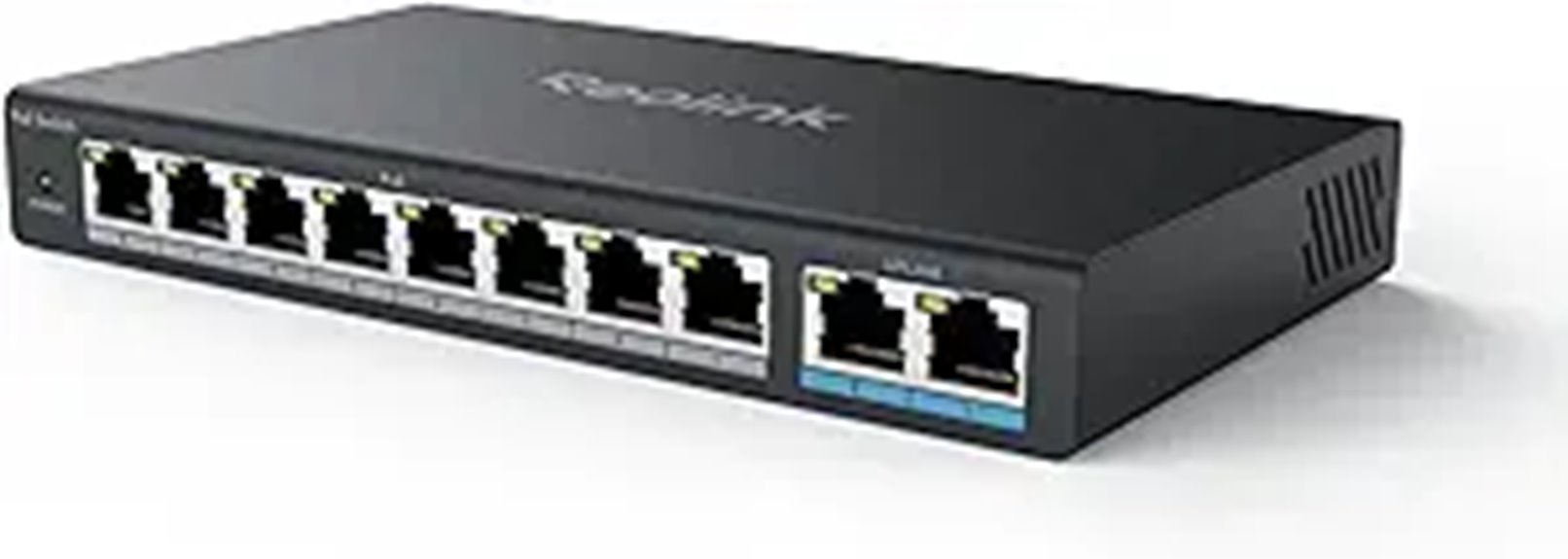
The REOLINK PoE Switch with 8 PoE ports and 2 Gigabit uplink ports stands out as an ideal choice for security-focused VoIP setups that require reliable power and data connections. It supports IEEE802.3af/at standards, delivering up to 30W per port with a total of 120W power budget, perfect for powering IP cameras and VoIP phones. Its plug-and-play design makes setup straightforward, while its durable metal casing guarantees long-lasting performance. With high-speed data transfer at 1,000 Mbps and intelligent power management, it guarantees seamless operation without lag or damage to connected devices. This switch is a reliable, cost-effective solution for ensuring smooth, uninterrupted communication systems.
Best For: users seeking a reliable, cost-effective PoE switch to power security cameras, VoIP phones, and network devices in surveillance or small business environments.
Pros:
- Supports IEEE802.3af/at standards with up to 30W per port and a 120W total power budget, ensuring reliable device power supply.
- High-speed data transfer up to 1,000 Mbps provides seamless network connectivity.
- Durable metal casing and flexible mounting options (wall or desktop) enhance installation versatility and longevity.
Cons:
- Ports are limited to 10/100 Mbps for PoE, which may restrict bandwidth for data-heavy applications like NAS.
- Power supply brick is not mountable, requiring additional planning for placement.
- Slightly limited uplink speed compared to higher-end switches, which might impact large-scale network performance.
STEAMEMO 5 Port PoE+ Switch, Managed Ethernet Switch

If you’re seeking a compact, managed switch that offers reliable PoE+ power for small networks, the STEAMEMO 5 Port PoE+ Switch is an excellent choice. It features two 1000Mbps PoE ports, two 100Mbps PoE ports, and a Gigabit uplink, with a total PoE budget of 52W—supporting up to 30W per port. Its enterprise-level features include VLAN, QoS, DHCP Snooping, and storm control, ensuring stable performance. The fanless design, durable metal casing, and advanced heat dissipation promote longevity. Easy to manage via web, software, or app, it’s perfect for small offices, smart home setups, and security devices needing reliable power and seamless connectivity.
Best For: small offices, home automation, and security setups requiring reliable PoE+ power and easy management.
Pros:
- Simple plug-and-play installation with easy management via web, app, or software
- Reliable PoE power delivery supporting multiple devices like IP cameras and Wi-Fi access points
- Durable, fanless metal casing with advanced heat dissipation for long-term use
Cons:
- Limited warranty of only 1 year
- Some advanced management features may require networking expertise
- Potential delays in delivery and limited support options
Gigabit PoE Injector 30W, 802.3af/at Power Over Ethernet

For anyone looking to extend their PoE network without replacing existing switches, the Gigabit PoE Injector 30W supports IEEE 802.3af/at standards and delivers up to 30W of power, making it ideal for powering high-demand devices like outdoor cameras, access points, and Wi-Fi routers. It features two gigabit ports—one for input and one for PoE output—and can transmit data and power up to 100 meters (328 feet). Its plug-and-play setup simplifies installation, with automatic detection to prevent damage. Reliable and affordable, this injector is a practical solution for expanding PoE coverage in residential, commercial, or surveillance applications.
Best For: Homeowners, small business owners, and network enthusiasts looking to expand or upgrade their PoE network without replacing existing switches.
Pros:
- Supports IEEE 802.3af/at standards with up to 30W output, suitable for high-demand PoE devices.
- Plug-and-play setup with automatic detection ensures easy installation and device safety.
- Transmits data and power over 100 meters (328 feet), ideal for remote or outdoor installations.
Cons:
- Lacks UL or ETL safety certifications, which may be a concern for some users.
- Limited to 2 gigabit ports, which might not suffice for larger network setups.
- No external power supply included; requires a standard AC cord for operation.
Factors to Consider When Choosing the Top Poe Switch for VoIP

When selecting a PoE switch for VoIP, I focus on factors like power budget capacity to guarantee your phones get enough juice and port management features for smooth operation. Compatibility with network standards and ease of installation are also vital, along with choosing reliable, durable switches that stand the test of time. Understanding these points helps me find the best switch to meet your VoIP needs efficiently.
Power Budget Capacity
The power budget capacity of a PoE switch is a critical factor because it determines how many VoIP devices you can support simultaneously without power issues. This capacity reflects the total wattage available to power all connected devices, directly impacting your setup’s scalability. For VoIP phones, a switch with at least 15W per port is recommended to ensure reliable operation and allow for future growth. If you have many phones or high-power models, look for switches with higher total power budgets, such as 120W or more, which can support multiple devices without performance drops. Always verify both the per-port power allocation and the overall power capacity to ensure your switch can meet your specific requirements and avoid potential power shortages during operation.
Port Management Features
Choosing a PoE switch with robust port management features is essential for ensuring reliable VoIP performance. Features like VLAN support and QoS prioritization help segment traffic and prioritize voice data, reducing latency and jitter. Advanced port controls, such as enabling or disabling individual ports, setting power limits, and prioritizing specific connections, optimize call quality and network efficiency. Monitoring tools for port activity, bandwidth, and device connections enable quick troubleshooting and better network oversight. Port mirroring and storm control prevent congestion, maintaining high-quality voice communication even during heavy data traffic. Additionally, remote management via web GUI or management software simplifies configuration and ongoing administration, making it easier to adapt your VoIP network as needs evolve. These port management features are critical for a seamless VoIP experience.
Network Compatibility Standards
Selecting a PoE switch that supports the right network compatibility standards is crucial for ensuring your VoIP system works smoothly. I recommend verifying support for IEEE 802.3af (PoE) and IEEE 802.3at (PoE+) standards to reliably power your VoIP phones. It’s also essential to check the switch’s total PoE power budget, ensuring it can handle all connected devices’ wattage requirements. Each port should deliver enough power—up to 15.4W for PoE and 30W for PoE+—to support your devices effectively. Additionally, confirm that the switch is compatible with your VoIP devices’ network protocols to prevent communication issues. Consider advanced standards like IEEE 802.3az for improved energy efficiency and network performance, ensuring seamless and dependable operation.
Ease of Installation
When it comes to setting up a PoE switch for your VoIP system, ease of installation can save you a lot of time and hassle. A plug-and-play switch with simple setup means you won’t need complex configurations or extra software, speeding up deployment. Managed switches with intuitive web interfaces or mobile apps make configuring VLANs, PoE settings, and network priorities straightforward. Features like auto-detection and auto-recovery help devices identify and power compatible VoIP phones automatically, reducing setup steps. Flexible mounting options, such as wall-mount or desktop placement, allow for versatile installation in various environments. Additionally, a fanless, silent design ensures noise-free operation, making installation in noise-sensitive areas effortless and unobtrusive. Overall, these factors considerably simplify the installation process.
Reliability and Durability
Reliability and durability are essential factors to contemplate because a PoE switch must consistently deliver power and maintain network stability over time. High-quality components and sturdy build materials, like metal cases, help withstand daily use and environmental stress. Compliance with standards such as IEEE 802.3af/at ensures dependable power delivery and ongoing network performance. Managed switches often offer enhanced reliability through features like auto-recovery, VLAN management, and firmware updates that fix bugs and improve performance. Fanless designs reduce moving parts, minimizing failure points and noise while requiring less maintenance. Additionally, protective features like lightning protection, short-circuit safeguards, and surge suppression shield the switch from electrical damage, ensuring longevity and consistent operation in demanding environments.
Advanced Security Measures
Security features play an essential role in guaranteeing your VoIP network remains protected amid increasing cyber threats. Implementing VLAN segmentation and port isolation can prevent unauthorized access and limit traffic between VoIP devices, boosting security and reducing vulnerabilities. Enabling port-based 802.1X authentication ensures only authorized devices connect, minimizing malicious access risks. Advanced QoS and traffic prioritization protect VoIP calls from latency, jitter, and packet loss caused by other network traffic, maintaining call quality. Incorporating IGMP snooping minimizes multicast traffic, reducing attack vectors and enhancing network security for VoIP communication. Regular firmware updates with security patches are crucial to address vulnerabilities and keep your network secure. Choosing a PoE switch with these advanced security features helps guarantee a reliable, protected VoIP environment.
Frequently Asked Questions
How Does Poe Switch Quality Impact Voip Call Quality?
The quality of a PoE switch directly impacts VoIP call quality because a high-quality switch provides stable power and reliable data transfer. If the switch is poorly made, it can cause power fluctuations or network interruptions, leading to choppy calls or dropped connections. I’ve experienced that investing in a good switch guarantees clear, consistent communication, avoiding latency issues or poor voice quality during calls.
What Is the Maximum Power Output per Port for Voip Devices?
The maximum power output per port for VoIP devices is typically 30 watts with PoE+ (802.3at) switches. I recommend checking your specific switch’s specifications because some advanced models can deliver up to 60 watts per port with PoE++ (4PPoE). Ensuring your switch provides enough power is essential for high-quality VoIP phones that require more energy for advanced features or multiple lines.
Can Poe Switches Support Future Voip Technology Updates?
Oh, absolutely, PoE switches are practically psychic—they can support future VoIP tech updates without breaking a sweat. It’s almost like they have a crystal ball! In reality, while many switches are designed with some flexibility, it’s wise to pick models that support higher power budgets and standards like 802.3at or 802.3bt. That way, you’re set for upgrades, not stuck with outdated tech.
Are There Specific Features to Prioritize for Voip in Unmanaged Switches?
When choosing unmanaged switches for VoIP, I prioritize quality of power delivery, port speed, and network stability. Look for switches with Power over Ethernet (PoE) support to guarantee reliable power to VoIP phones, and gigabit ports for smooth data flow. Also, features like VLAN support and traffic prioritization help reduce latency and interference, making your VoIP calls clearer and more reliable without needing advanced management features.
How Do Environmental Factors Affect Poe Switch Performance for Voip?
Think of a PoE switch as a sturdy bridge, carrying voice data across turbulent environmental waters. Excessive heat can cause it to overheat, just like a bridge warping under the sun. Cold temperatures might make components brittle, risking failure. Humidity encourages corrosion, like rust eating away at metal. To keep your VoIP reliable, place switches in controlled environments, shielded from extreme heat, cold, and moisture, ensuring smooth, uninterrupted communication.
Conclusion
So, after all this talk about reliable power and seamless connectivity, it turns out choosing the right PoE switch is as easy as picking a needle in a haystack. Who knew that a tiny switch could make or break my VoIP calls? Maybe I should just toss a coin—either way, with the right choice, you’ll be chatting smoothly while I enjoy the irony of overthinking a simple switch. Happy connecting!


